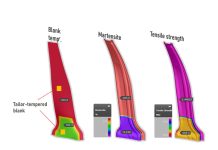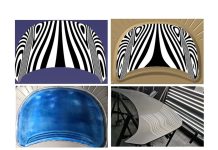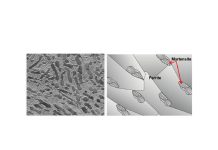How best to handle material behaviors for simulation
[dropcap]I[/dropcap]n this article Yurdaer Demiralp, Senior Application Engineer from AutoForm USA, provides an overview describing how exactly software solutions are able to effectively simulate sheet metal forming. This post lays the foundation for further studies.
The challenges to achieve high quality simulations for sheet metal forming are increasing with increased use of high grade strength materials. Obtaining specifications of material properties correctly and using these properties with ideal constitutive laws in finite element analysis for formability investigations remain a constant challenge for achieving highly accurate sheet metal forming simulations.
The formability or drawability – that is the ability to shape sheet material to a defined part geometry – is mainly finding the balance between wrinkle and split limitations of a sheet material’s mechanical properties. This is applied to the severity of the desired part geometry by adjusting the sheet material flow, mainly by controlling the binder force (Figure 1).
When viewing formability through this concept, too little binder force will cause the sheet metal to wrinkle vs. too much binder force will cause material splits. Thus the mechanical properties of the sheet material, such as the hardening curve or the yield surface, act like a GPS that helps us to know if a designed process or part is feasible within the limits of those values.

Figure 1: Sheet metal forming process windows
To investigate the formability of a sheet material, we have to describe mechanical properties in mathematical form. Yurdaer said ‘Firstly we need to understand the connection or relationship between finite element analysis and sheet material behavior. Sheet material behavior is reverse engineered in sheet metal forming simulations so that the accuracy of the forming simulation results strongly depend upon the material model; modelling elastic properties, plastic deformations or the hardening curve (flow stress) and the yield surface.’
Starting with a blank of sheet material two questions must be answered:
- What are the mechanical properties of the sheet material?
- How is this sheet material characterized in terms of obtaining its mechanical properties required for simulation?’
Generally, a standard uniaxial tensile test (Figure 2) is easy to perform and well accepted for determining the mechanical properties of materials.

Figure 2: Typical tensile testing, tensile stress-strain curve,
optical strain measurement from tensile testing, true stress-strain curve
with various extrapolation BBC 2005 yield surface, Forming limit curve.
The true stress-strain data is the real sheet material property that is used in sheet metal forming simulations. There are several reasons why tensile stress-strain data is not suitable. Firstly, it is based on an initial cross sectional area of the test coupon rather than the actual value. Also, the tensile strain is based on the original gauge length and hence offers no satisfactory measurement as well. To overcome these disadvantages the true stress-strain data that is calculated from the tensile stress strain data is used in sheet metal forming simulations.
In addition, we need to be aware that tensile tests have limitations in terms of obtaining sheet material properties when used in calculations for sheet metal forming simulations. The true stress-strain data captured from uniaxial tension conditions in a tensile test is limited because of localized necking, followed by fracture as shown figure 2. Uniaxial tensile testing yields limited stress-strain data since in typical sheet metal forming processes the sheet metal generally is subjected to biaxial stretching conditions (a more desirable deformation mode) allowing the material to be stretched to a much greater extent. Therefore, true stress-strain data obtained from tensile tests need to be extrapolated as shown in Figure 2 to accommodate higher levels of strain such as from biaxial deformation conditions.
In a tensile test, there are two types of deformation: elastic, reversible from zero to yield stress and plastic, irreversible from yield stress to ultimate tensile stress. There is a one-to-one relationship between stress and strain under elastic deformation. If we know the stresses we can calculate strain or vice versa. However, if the sheet material undergoes various plastic deformation modes (Figure 3) during forming – such as uniaxial tension, uniaxial compression, plain strain, biaxial stretching, biaxial compression, shear etc. – the yield surface determines how the material flows plastically for a given strain path.
A well suited yield surface description including a quantitative description of plastic anisotropy defines multiaxial plastic material flow and is required to obtain accurate simulation results.

Figure 3: Schematic of yield surface data points for different stress states
AutoForm utilizes classical formulas, such as Hill-48 and Barlat-89 as well as advanced yield surface models, like BBC-2005 and Vegter, all well accepted in our field.
Simulation results of formability such as thinning, wrinkles, surface defects, springback, edge and surface cracks mainly depend on how the material behaves as defined by the numerical material model and data used.
During early feasibility studies a user can select a reference material file from our comprehensive AutoForm material library. Adopting this approach means at the outset you can run your initial simulation right away on the basis of readily available material data. However, for highly accurate simulation results you need to make sure that the material data used in the simulation accurately describes the properties of the actually used sheet material for the production of the part. This may be achieved by obtaining relevant material data from your customer or – if this is not available – you need to get your material tested at a testing lab. Having a material file accurately describing the actual material at hand, created using data from actual testing, is a necessary prerequisite for obtaining highly accurate simulation results that ‘tell the truth so to speak.’
In addition, variation of sheet material properties occurs from supplier to supplier, from coil to coil and even within coils. Considering the limits of uniaxial tensile tests (discussed above) and the theoretical assumptions made during sheet material characterization, such as yield stress definition at 0.2% strain especially for Advanced High Strength Steel (AHSS), the extrapolation of hardening curves, may also be a source of variation of simulation results compared to an actual part. Therefore, to get the full picture of the process capability, it is necessary to run additional sensitivity studies to obtain robust simulation results, as schematically shown in Figure 4.

Figure 4: Schematic of considering material noise variation
to obtain robust simulation results.
Ultimately, the consideration of these variations by using AutoForm robustness analysis in feasibility studies will help create a sheet metal forming process (or tooling) that will accommodate incoming material noise variations yet still produce parts that pass inspection.
‘Every simulation has material behavior at its foundation. As we often say at AutoForm: “garbage in – garbage out.” If you commence with ‘good’ input of the material data you’re going to have ‘good’ output for simulation accuracy.’ Yurdaer Demiralp, AutoForm USA.
Thank you Yurdaer for this insightful interview.
About the Author: Yurdaer Demiralp works AutoForm US office as Senior Application Engineer. He has nineteen years of experience in the sheet metal forming field.
For new visitors don’t forget to sign up to our blog. We’ll never push marketing on you. You’ll only ever receive one email per month highlighting our latest posts.













